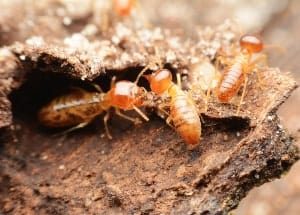Termites are a nightmare for any homeowner, but unfortunately, they are not the only threat posed to your home by tiny creations with wings. In fact, certain types of bugs that look like termites are often responsible for doing just as much (if not more) damage to your property.
If you suspect that you and your family may no longer be the sole inhabitants of your home, it is crucial that you identify the intruding bugs before taking any measures.
Let’s take a closer look at some termite look-alikes and find out how to tell these species apart.
Flying Ants vs Termites
Unlike termites, flying ants do not eat wood. This means that a flying ants infestation is most likely not going to cause serious damage to the structural elements of your home.
Still, seeing tiny bugs with wings in your house is definitely not something you want to experience, especially since flying ants are drawn to food debris.
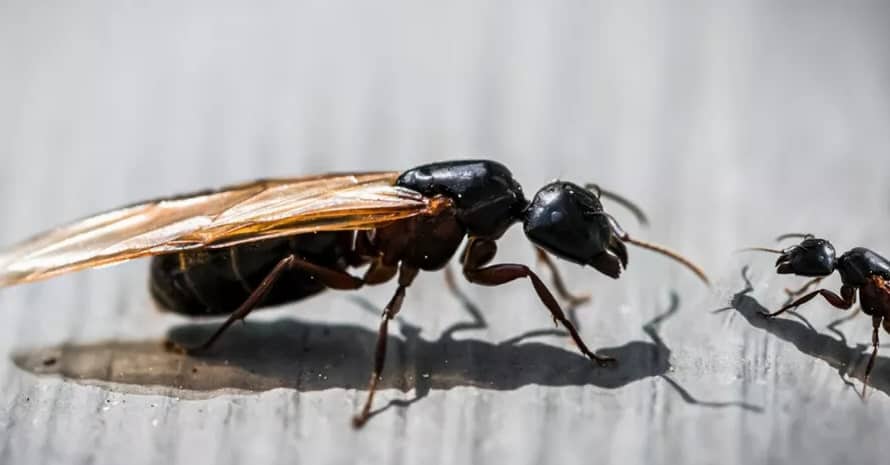
If the wooden objects in and around your home seem intact, but you’re not yet ready to conclude that the intruders are in fact flying ants and not termites, your best bet is observing the bugs from a close distance.
Both flying ants and termites live in colonies, but their appearance differs in a number of ways, which can help with ant vs termite identification.
Flying ants have rather pronounced waists, so the bottom part of their bodies is noticeably wider than the top one. Termites’ bodies have straight waists with two pairs of clear wings of equal length.
Flying ants sport brownish wings, and the front pair is longer than the back one. Finally, flying ants have bent antennae, as opposed to straight ones found in termites.
Termites vs Carpenter Ants
Termites and carpenter ants may be extremely difficult to tell apart, as they display similar traits and even look quite alike. Still, you can rely on several sure signs to help you identify a carpenter ant infestation as opposed to a termite one.
First of all, there are some differences when it comes to carpenter ant frass vs termite frass comparison. Carpenter ants dispose of their waste during the process of digging the tunnels, while termites have dedicated “kick-out holes” that are repeatedly used to remove dry fecal pellets from their colony. If you see piles of these pellets, your house is most likely infested by termites.
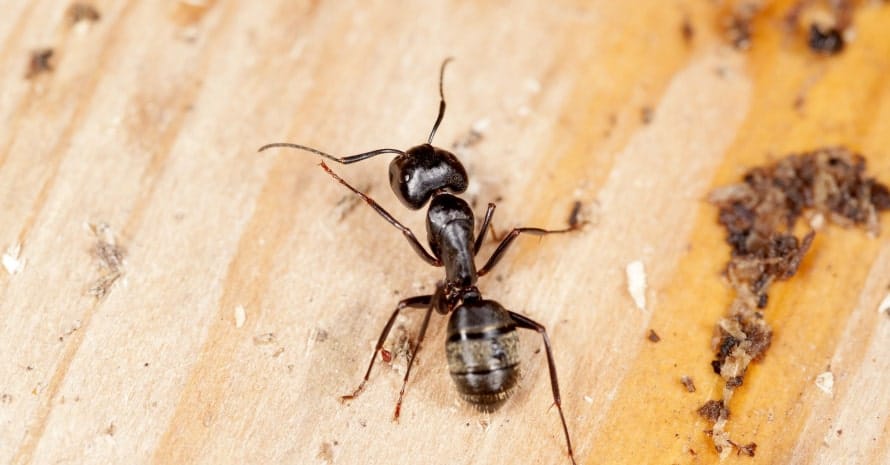
Another telltale sign of a termite infestation are mud tubes. Built by the termites to separate their living quarters (soil) and food (wood), they are not to be found in carpenter ants colonies.
You can also inspect the tunnels in the affected wooden surfaces, as the carpenter ants tunnels tend to be a lot cleaner and smoother than those left by termites.
Finally, there are some visual differences between carpenter ants and termites. The former have a 3-segment body with a distinct waist. Carpenter ants’ wings are about as long as their bodies, while termites have much longer wings.

Termites vs Carpenter Bees
Carpenter bees are pretty easy to tell apart from termites, both due to their differing exteriors and behaviors. Carpenter bees are independent insects that don’t form colonies, even if a number of them choose to live in the same wooden object.
Every carpenter bee makes itself a nest by “drilling” into the chosen wood habitat and eventually creating a rather large funneling hole.
These holes are commonly mistaken for termite “kick-out holes”, but the holes created by termites are usually smaller than 0.1in in diameter. Anything larger than that is highly unlikely to be associated with termite “kick-out holes”.
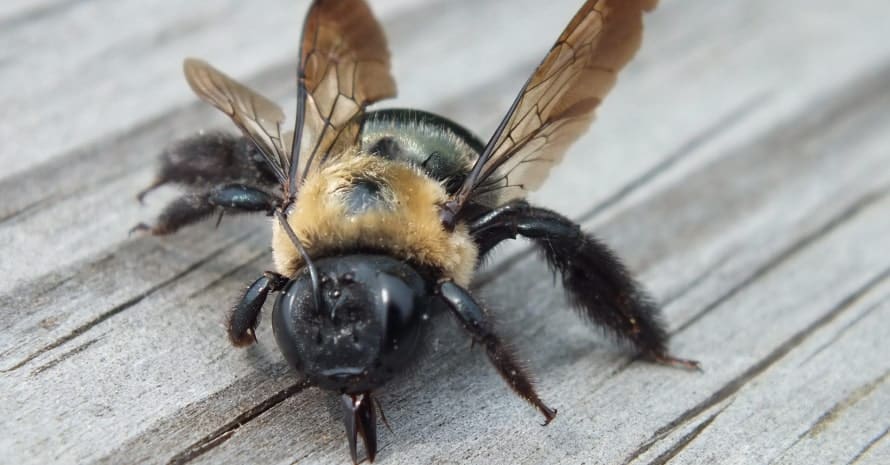
While termites are usually not very picky when it comes to wood, carpenter bees do have some strong preferences. If your property has any unpainted and otherwise chemically untreated wooden structures, it is definitely a target for carpenter bees. Softwoods such as oak or cypress are particularly attractive to these insects.
Since carpenter bees don’t form colonies, it is not very likely that these insects are going to cause any significant damage to your home.
However, these bright yellow “wood bugs with wings” produce a characteristic buzzing sound when they fly, which often terrifies children and even some adults.
Because of that, many homeowners want to take care of a carpenter bee infestation as soon as possible. Still, it is worth knowing that male carpenter bees don’t have a stinger at all, and female ones are very unlikely to attack humans unless threatened directly.
Termites vs Powderpost Beetles
Powderpost beetles may not be the most termite-looking bugs out there, but they are definitely very similar to termites when it comes to the amount of damage caused. Powderpost beetles love damp wood, so their infestations are most commonly discovered in spring and summer.
They are a lot more destructive than most wood bugs that fly, so it is important to take care of a powderpost beetle infestation as soon as you find it.
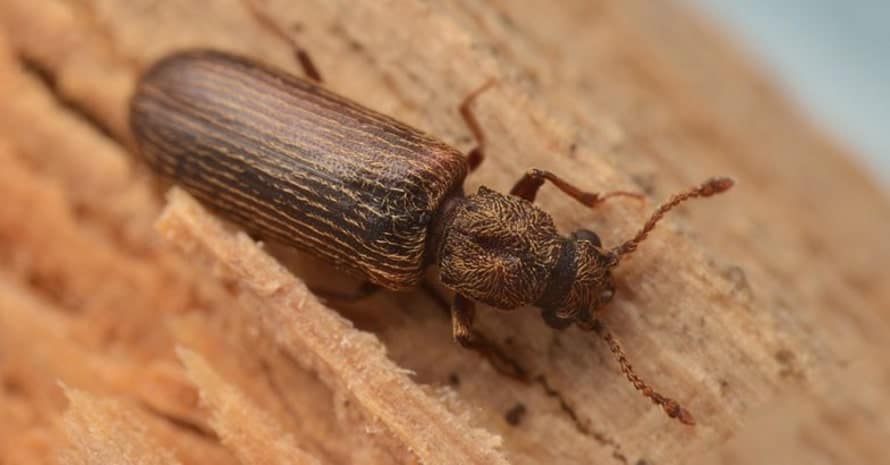
Powderpost beetles chew through wood as they build their nests and create tunnels to exit them once they’re done. The larvae found in the nests can produce rather loud clicking sounds, so professional exterminators often use a stethoscope to check for potential powderpost beetle infestations and locate them if any are found.
The tunnels leading to powderpost beetle nests usually contain noticeable amounts of powder that is left behind by the beetles as they process the wood.
It is not uncommon for a homeowner to find their property infested by powderpost beetles after acquiring a piece of wooden furniture or basically any other wooden object containing larvae.
Thus, it is important to be very careful when bringing new wooden items into your home, as powderpost beetles can be a lot more difficult to locate and get rid of than winged bugs that look like termites (such as carpenter ants).
FAQ
Let’s figure out some more termite basic features.
How small are termites?
Termites are quite small insects, similar in size to common ant varieties (which is the primary hurdle to reliably telling these species apart).
Most termites you can encounter in America are in the 0.2-0.6 inch range, although the queens of these species are known to be a lot larger, measuring at up to 4 inches in length.
What color are termites?
Depending on the species, termites can be yellowish, brown, red, or black. Flying termites, also referred to as swarmers, are the most common termite variety encountered by homeowners, and they are highly likely to be either yellow or black.
Do carpenter ants have 2 sets of wings?
Similar to termites, carpenter ants also have 2 sets of wings. However, the ants’ wing pairs differ in size, with the front one being noticeably longer than the back one.
Also Read: Best Termite Bait Stations
Once You’ve Identified Bugs That Look like Termites in Your Home
Knowing the type of insect infesting your property allows you to identify the measures required to get rid of unwanted visitors. Most insects that look like termites can be eliminated with certain chemical products, most of which are freely available for purchase.
Going DIY on a small, recent infestation might be enough, but if you’re dealing with a more serious bug problem, professional exterminators are the way to go.
Did you already have to deal with bugs that look like termites? Do you have any tips you’d like to share or questions you’d like to ask? If so, don’t hesitate to do that in the comments section below.
References:
- Powderpost Beetles (by Michael F. Potter, Extension Entomologist University of Kentucky College of Agriculture):
https://entomology.ca.uky.edu/ef616 - Carpenter Bees (C.E. Mall, T.A Horner, N.L. Breisch (retired) and B.L. Thorne (retired), Department of Entomology, University of Maryland, College Park, MD):
https://extension.umd.edu/hgic/topics/carpenter-bees - Carpenter ants (University of Minnesota Extension):
https://extension.umn.edu/insects-infest-homes/carpenter-ants - Flying Ants (University of Wisconsin-Milwaukee):
https://uwm.edu/field-station/flying-ants/

